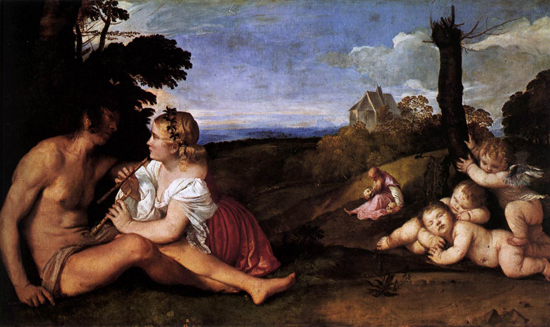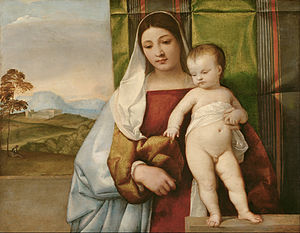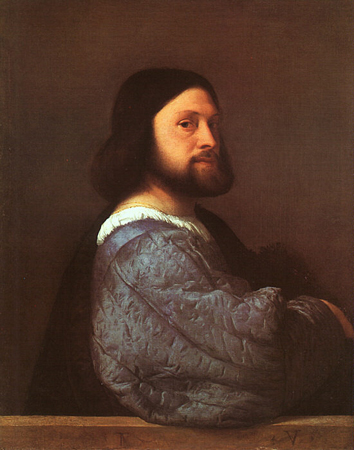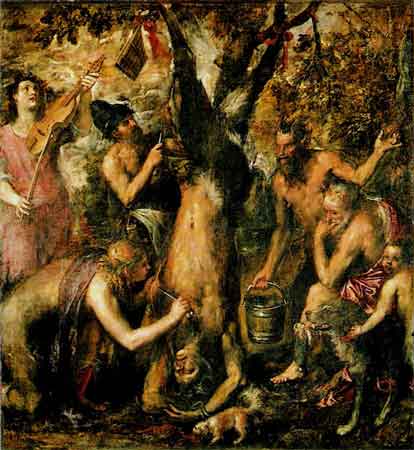|
Crystal Hancock - Titian: A Short Biographical Sketch

Self-portrait (early 1550's)
Tiziano Vecellio, better known as Titian, was born in Peve di Cadore
to a rather prosperous family; however, unlike most artists of the time,
he did not come from a family of artists. His father, Gregorie DI Conte
dei Vecelli came from a line of soldiers and governmental officials
and little is known of his mother Lucia (Cole 1999).
There is much debate as to the actual date of his birth since no actual
record exists. In a letter written by Titian to Philip II in 1571, the
artist complains of being ninety-five years old, which would place his
date of birth in 1476. Most modern scholars, however, believe the artist
was actually born somewhere between 1488 and 1490 (Pedrocco
1993). The actual year of Titianís birth is important so
that the chronology of his works can be accurately pieced together;
therefore, this is not a trivial issue.
|
Despite the controversy surrounding his birth date, it is obvious
that Titian was quite young when he first got started, probably
around ten years old. At this time, he and his brother Francesco
went to Venice to live with their uncle. While in Venice, they
got their first experience in the workshop of Sebastiano Zuccato,
who was a prominent mosaicist of the time. From there, Titian
went on to work with the Bellini brothers, Gentile and Giovanni,
leading artists of the day. It was in the Bellini studio that
he met the young Giorgione. The style of this artist around
the time Titian met him relied heavily on gradations of tone
rather than line and he showed a preoccupation with landscape
(Hope 1980). Titian was influenced
by this style, as seen in The Three Ages of Man from
1511-1512.
|
|
|
|
The first works of Titian are not documented; however,
it is thought that he worked on many devotional paintings prior
to the first documented work in 1508. These devotional paintings
were done in the style of Giovanni Bellini, indicating that they
were probably completed prior to the documented frescoes. The
subject of these early paintings was usually the Madonna and child,
either alone or in the presence of saints. The figures were half-length
and placed before a landscape, drapery, or prop, a style popularized
by Giovanni (Cole 1999). The most
famous of these paintings is the Gypsy Madonna, which is
unsigned and undocumented like most of the earlier works of Titian.
|
| The Santo frescoes, completed in 1510, were the
first documented works by Titian. It is seen in these works that
Titian has moved away from the style of Giovanni Bellini. The
detail of these works indicates that these were more than likely
not the paintings of an inexperienced artist, illustrating the
point that these were probably not indeed the first works of this
artist (Cole 1999). Titian also
did some early portraits around this time, including the Portrait
of a Man from around 1512. In these early paintings, idealization
was quite important to the artist. |
|
|
|
In 1516, Giovanni Bellini passed away,
and Titian became the official painter of the republic. During
this middle period of Titianís career, he painted many mythologies
and religious paintings. He painted the Assumption of the Virgin,
which is the worldís largest painting on panel (690 x 360 cm).
This piece was intended for the altar in the choir of the Franciscan
Church of Santa Maria Gloriosa dei Frari in Venice. It was commissioned
sometime around 1516 and completed around 1520. Titian also painted
many courtesan portraits that were popular at the time. This type
of portrait depicts the courtesansí upper body in a state of undress
and usually with an "attribute that suggests a mythological
or allegorical identity" (Cole 1999).
Titianís Flora of 1520 is an excellent example of this
style portrait, containing all of the elements. |
Titian was gaining much acclaim with his painting; however, it was
his portraits of the next part of his career that would make him famous.
Portraits were quite important to the Renaissance society in order
to project the image and nature of the rulers since they had no photographic
devices (Cole 1999). By painting famous
personages, artists such as Titian could become quite successful.
Among those painted by Titian were the Holy Roman Emperor Charles
V and Pope Paul III. Charles V went on to appoint him court painter
and give him the rank of Count Palatine and Knight of the Golden Spur
(Cole 1999).
| In Titianís later works, he again portrayed many
mythological and religious scenes; however, the style had changed
tremendously. The forms lost their solidity and the color was
more intense. Titian referred to his later paintings as poesie
(poems) (Pedrocco 1993). Many of
Titianís later works reveal a sense of tragedy, as seen in the
Flaying of Marsyas from 1570. In his final works, he often
added finishing touches with his fingers. His final work was Pieta,
which he created for the Chapel of Christ in the Frari Church,
the place where he was to be buried. When Titian passed away on
August 27, 1576, the work was incomplete and was completed by
Palma the Younger who merely added glazing and some final touches
(Pedrocco 1993). |
|
Titian lived a long and productive life, although we do not know exactly
how long due to the absence of a record of his date of birth. He was
a famous Venetian painter, whose works, especially his portraits, gained
him international acclaim, something not known to artists before him.
In the words of Vasari, who is best known for his book on Renaissance
painters, "there was almost no famous lord, nor prince, nor great
woman, who was not painted by Titian."
|





